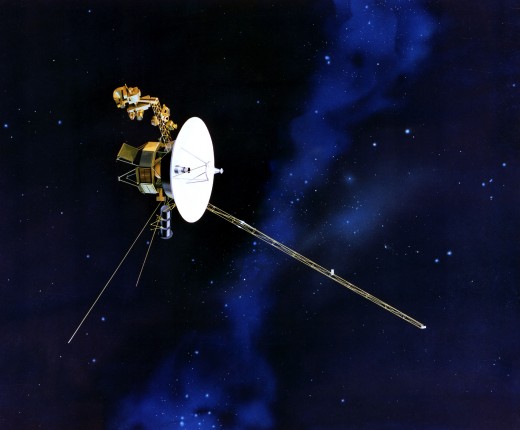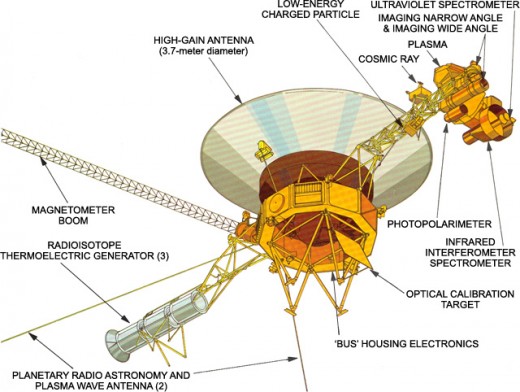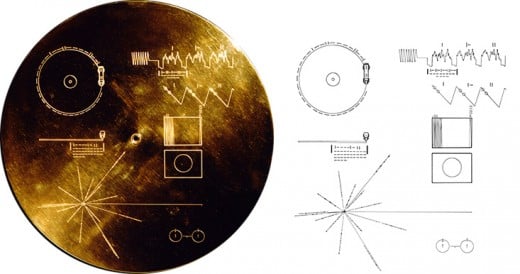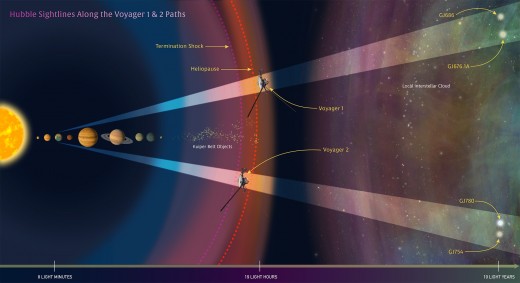Where are the Voyager Probes Now?

Love, hated but never ignored, the Voyager Space Probes have literally earned the most milestones than any other human made objects in history. Launched forty years ago, the twin probes now travel beyond the Solar System still pushing the knowledge of space and beyond. Unlike, their Pioneer predators, both Voyagers still function and still continue to communicate with NASA on a daily basis. Undisputedly they will venture where no probe has come before. So where are the Voyager snow?
The Mission
Originally part of NASA's highly successful Mariner program as Mariners 11 and 12, the two probes later evolved in design to the point they outclassed the rest of the Mariners, thus earning a new name; Voyager.
The cosmos dictated when the Voyager probes were to take to the heavens. Favorable once every 175 year alinement of the outer gas giants in 1977 allowed NASA to focus a series of launches to study these planets all at once.
Mission of Voyager 1
To explore Jupiter, Saturn, and Saturn's largest moon Titan.
Mission of Voyager 2
To first explore Jupiter and Saturn, then serve as Voyager 1's auxiliary and finally exploring Uranus and Neptune.

Probe Design
Designed by NASA's Jet Propulsion Laboratory in the early 1970s, the Voyagers were packed with the most powerful and advanced technology, antennas and instruments then conceived.
Sixteen thrusters, multiple gyroscopes and celestial tracking systems where designed with the sole purpose of keeping a massive twelve foot high gain antenna dish pointed towards earth at all times. This antenna was specifically designed for use well beyond the solar system as NASA anticipated both probes to reach interstellar space in their operational lifetimes.
Both Voyager probes are nuclear powered. Since sunlight is not the strongest at the outer planets, solar power was not an option. A cylinder of plutonium spheres generate the wattage needed to power all instruments on board. There's enough energy to power the probes through the 2020s. As the probes track deeper into space, one by one, their scientific instruments are powered down to conserve this slowly failing power source. The plutonium will continue to generate power through the 2080s but it won't be enough to really do anything.
Armed with eleven scientific instrument systems that could function in tandem or independent of each other for every conceivable variable that the probes could come across. These systems included imaging cameras, spectrometers, magnetometers, plasma measuring devices and radio instruments. NASA made sure these probes could be as balanced as possible as they ventured into the unknown.

The Golden Record
The most famous of all Voyager features, nothing sums up human optimism to find extraterrestrial life than the golden record. Chaired by Carl Sagan, a committee carefully chose a selection of images, sounds and music that represent humans of the twentieth century. These were encoded onto a twelve inch gold plated record as either a communication device to alien life or as a time capsule should future humans rediscovers the probes. The probes carry identical disks.
The Launch
Voyager 2 was actually launched first on August 20, 1977. Voyager 1 launched a few weeks later on September 5, 1977.
It would take two years for the probes to reach the outer solar system. Because of 1's faster trajectory, it actually reached Jupiter first. It began sending photos back in January 1979 and would spend four months studying the gas giant. In late 1980, Voyager 1 arrived at and began its Saturn observations. This lasted for two months from November to December. Afterwards it used Saturn's gravity to slingshot itself towards deep space and it's extended mission.
Voyager 2 arrived at Jupiter in July 1979 and began its research. It discovered Jupiter's thin dust rings and active volcanos on the moon Io. The probe also had a chance to study Jupiter's Great Red Spot. Voyager 2 spent a month studying Jupiter, a month with Saturn, a month with Uranus and a month and a half with Neptune. After using Neptune's gravity, Voyager 2 launched itself into deep space.
MIssion Milestones
Year
| Event
|
|---|---|
1980
| Voyager 1's Photopolarimeter Subsystem is powered down due to degraded performance.
|
1990
| NASA receives the very last photos taken from Voyager 1 to create a panorama called "The Family Portrait". Both imaging systems are powered down permanently.
|
1991
| Voyager 2's Photopolarimeter Subsystem is powered down due to degraded performance.
|
1997
| The Voyagers celebrate 20 years in space.
|
1998
| Voyager 1's Infrared Interferometer Spectrometer and Radiometer is powered down to save power.
|
1998
| Voyager 1 overtakes Pioneer 10 as the further human made object.
|
1998
| Voyager 2's Ultraviolet Spectrometer is shut down to save power.
|
2004
| Voyager 1 enters the heliosheath, the final layer before interstellar space.
|
2007
| Voyager 2 enters the heliosheath.
|
2007
| Voyager 2's Infrared Interferometer Spectrometer and Radiometer is powered down to save power.
|
2007
| Voyager 2's Plasma Wave System is powered down due to degraded performance.
|
2007
| The Voyagers celebrate 30 years in space.
|
2008
| Planetary Radio Astronamy systems are shut down on both Voyagers to conserve power.
|
2010
| Voyager 2 suffers data formatting problems as the result of a memory bit failing. The computer was reset and the faulty bit isolated and rendered 'off limits'.
|
2011
| Voyager 2 is switched to auxilary thrusters to save power.
|
2012
| Voyager 1 exits the heliosheath and officially enters interstellar space.
|
2016
| Voyager 1's Ultraviolet Spectrometer is shut down to save power.
|
2017
| The Voyagers celebrate 40 years in space.
|
2017
| Voyager 1's primary thrusters are powered up for an alinement adjustment. This is the first time since 1980 they have been used.
|

Current Location
Voyager 1 remains the furtherest human made object from Earth, a title it will hold for the conceivable future. The distance as calculated by NASA is 1.74×1010 kilometers or 116 AU. That's 11.6 billion miles from Earth. Voyager 2 is not far behind at nearly 11 billion miles. Providing Voyager 1 isn't destroyed by space debris, it will reach the Oort Cloud in about 300 years, a milestone that will take 30,000 years to completely cross. Voyager 2 will take approximately 40,000 years to pass the closest star at 1.6 lightyears away.
Source
- Voyager
The official website of the Voyager Program. All images were pulled from official NASA resources.








